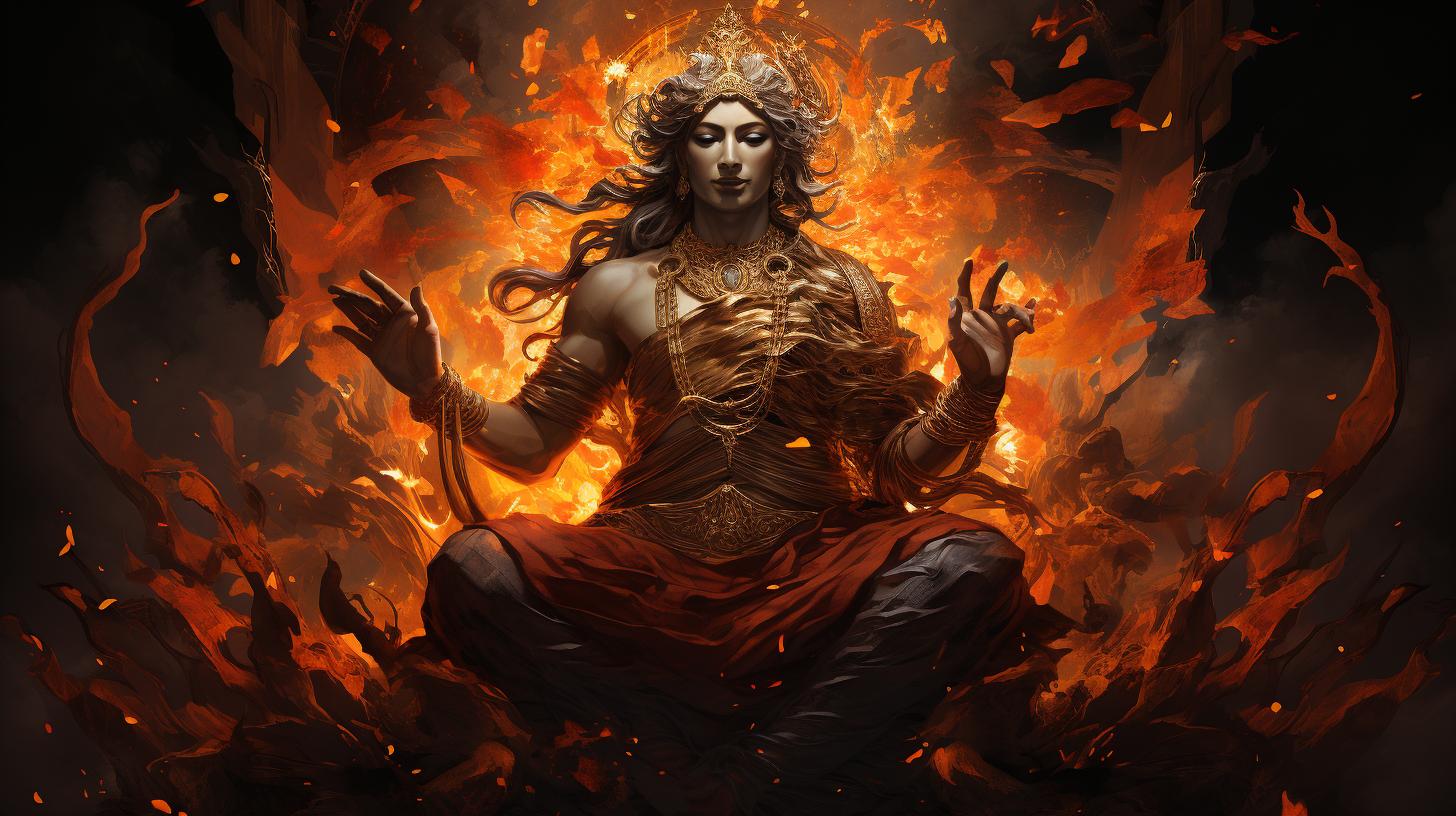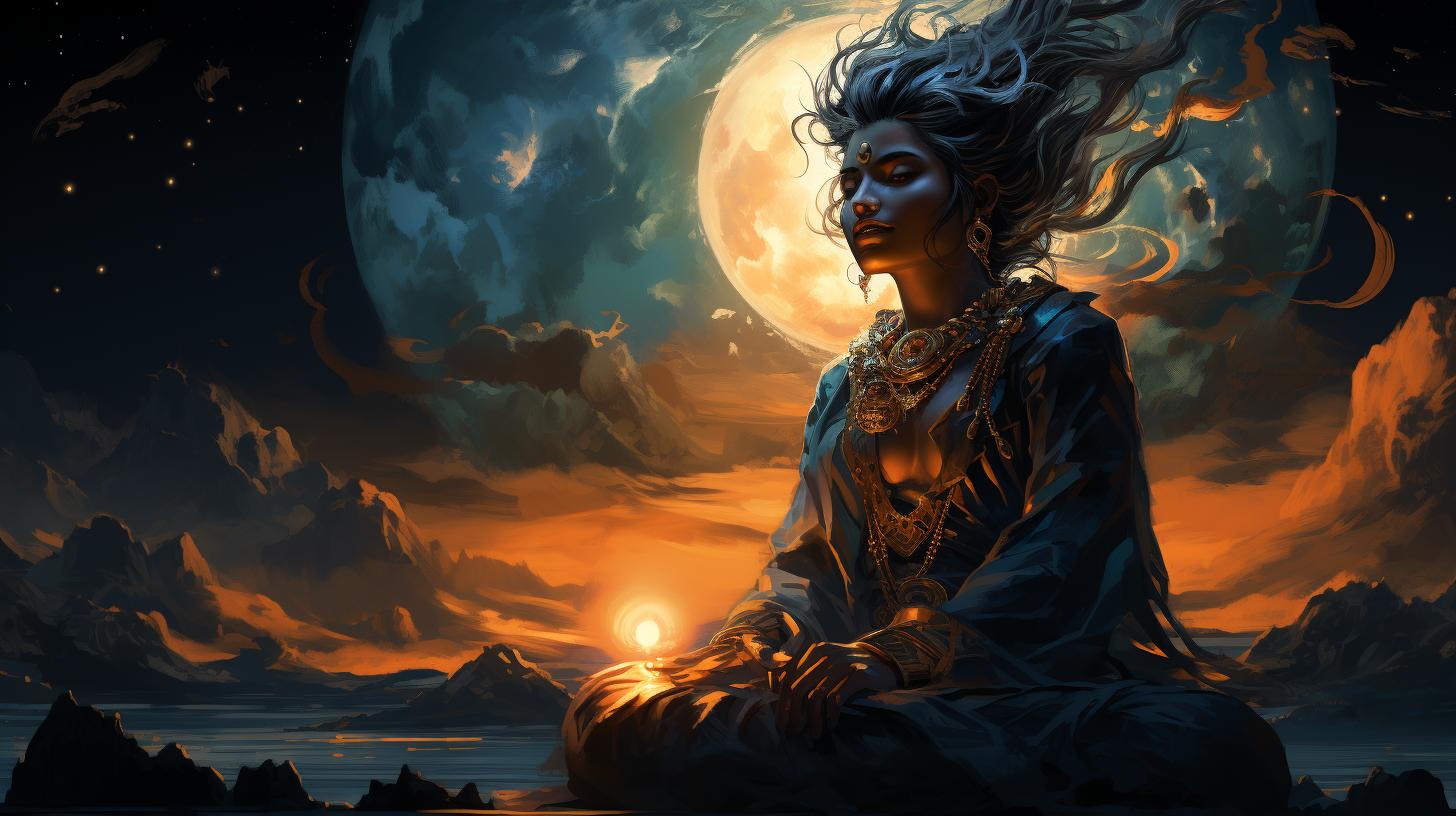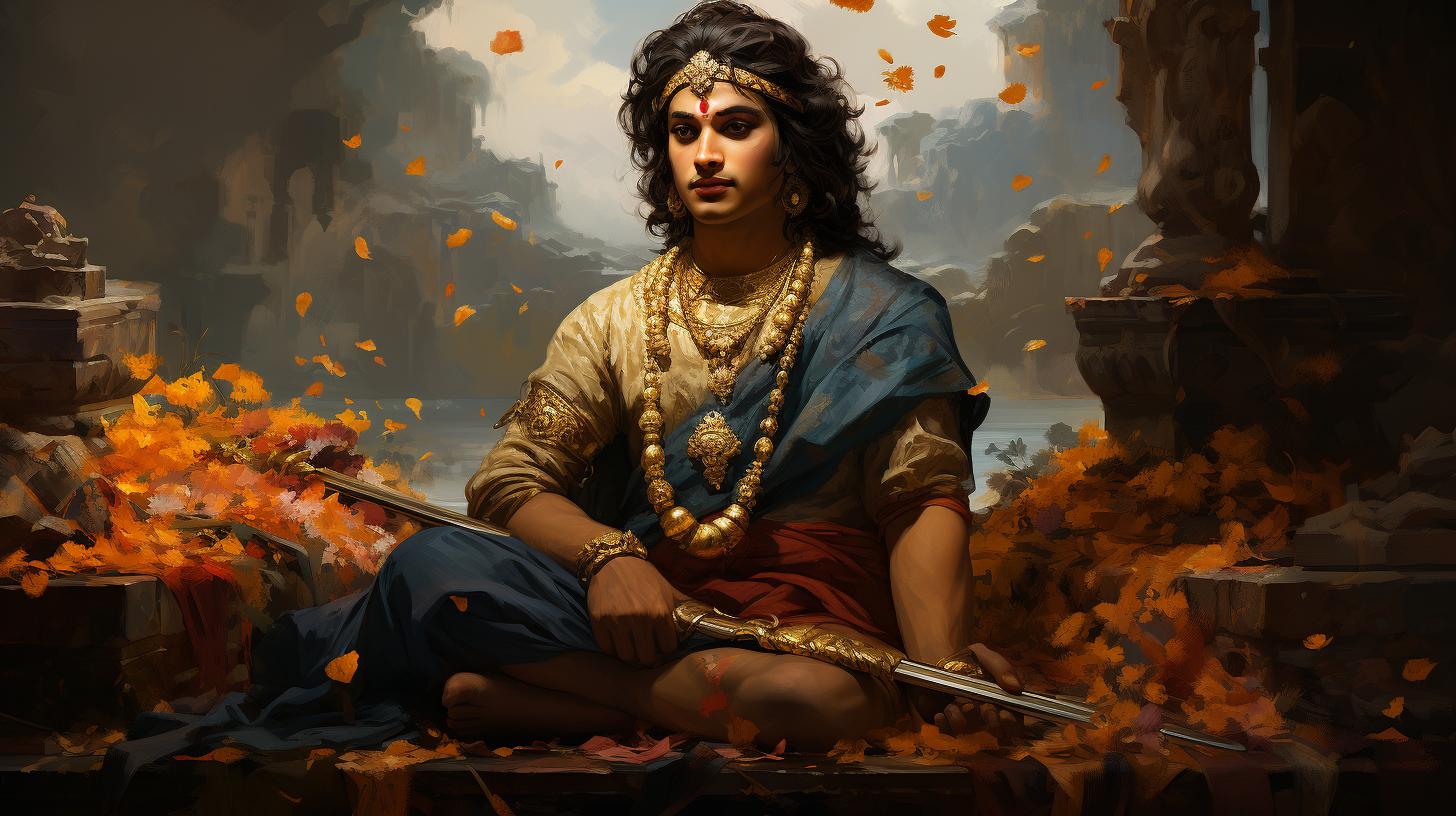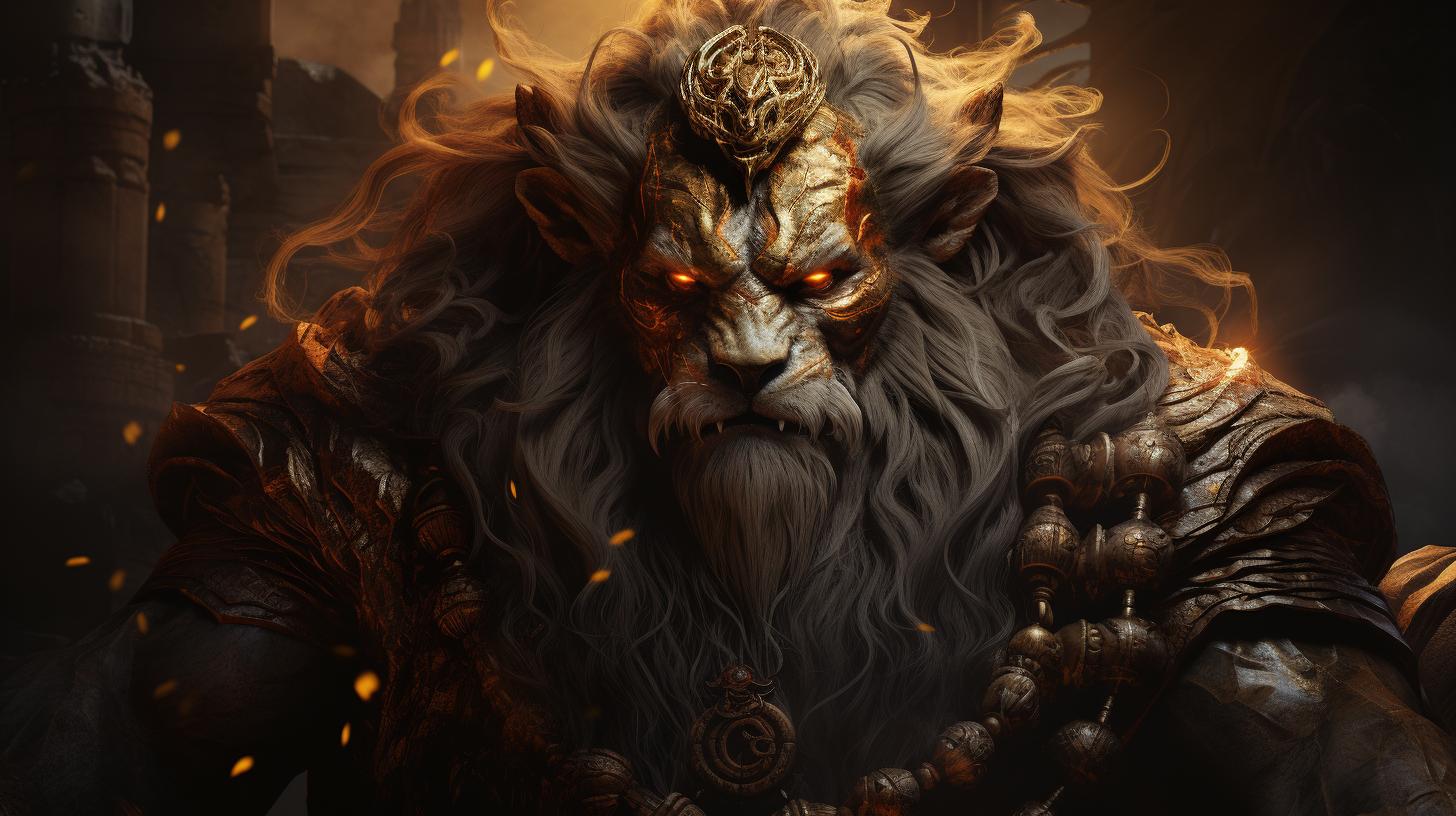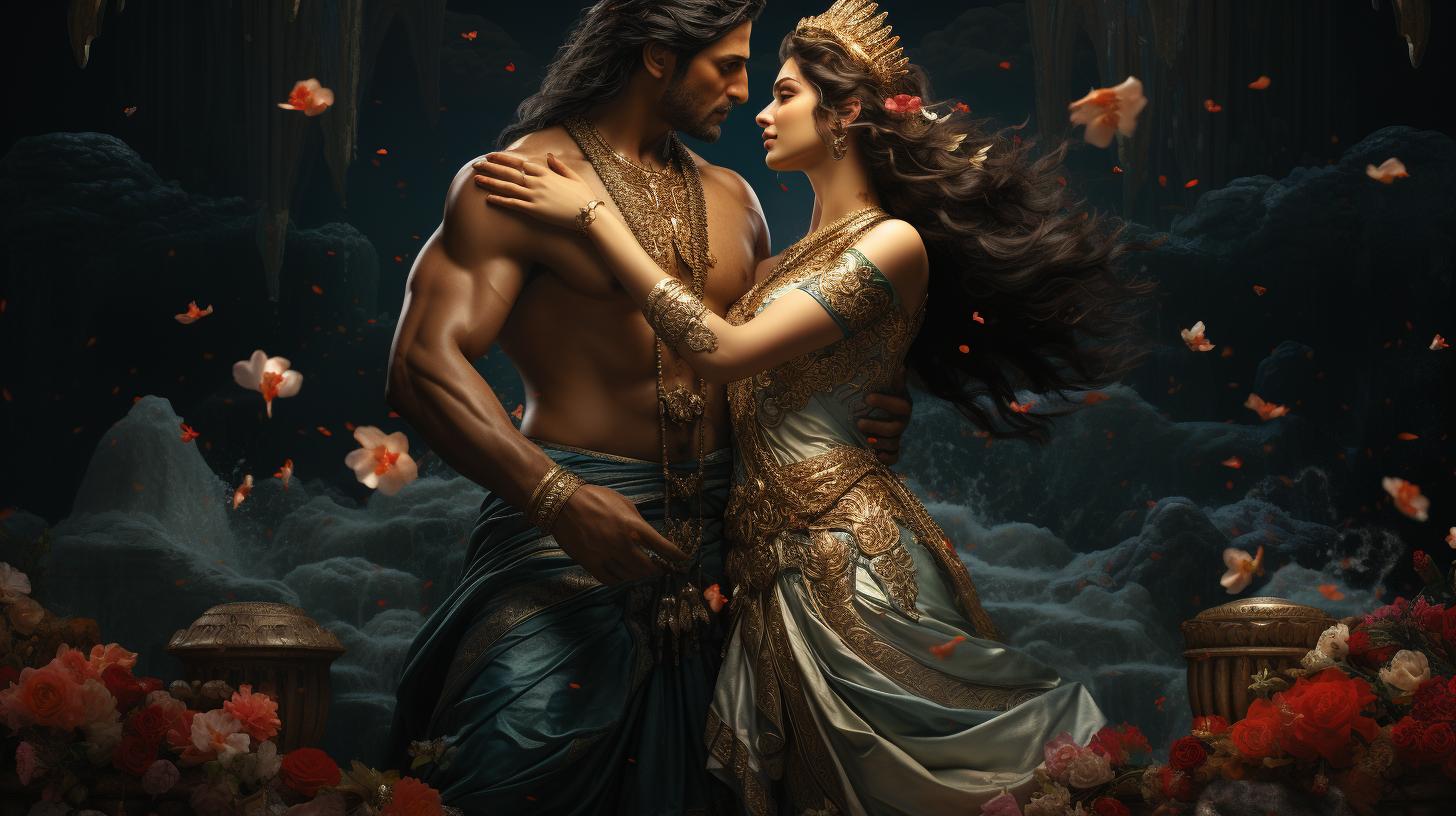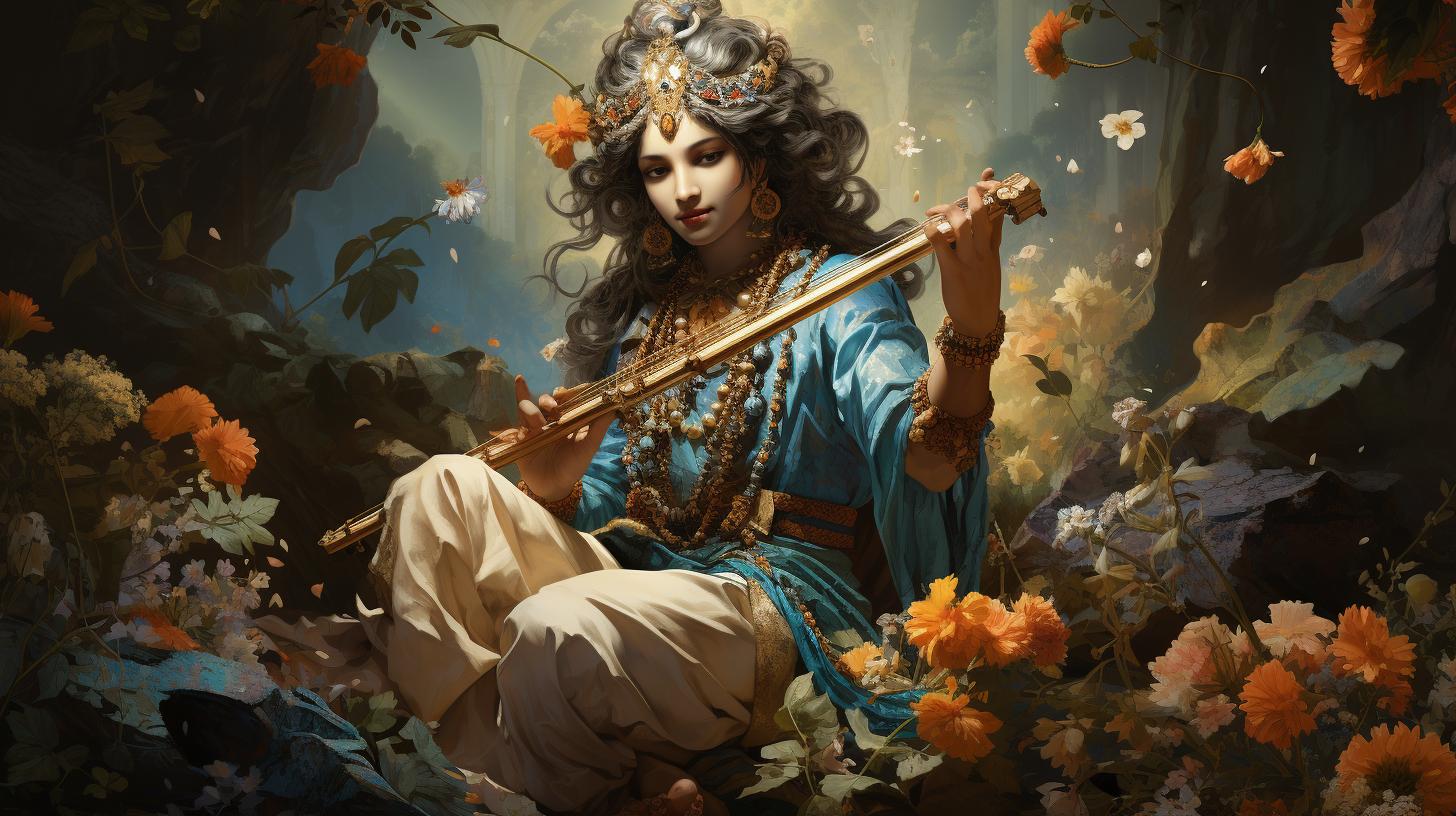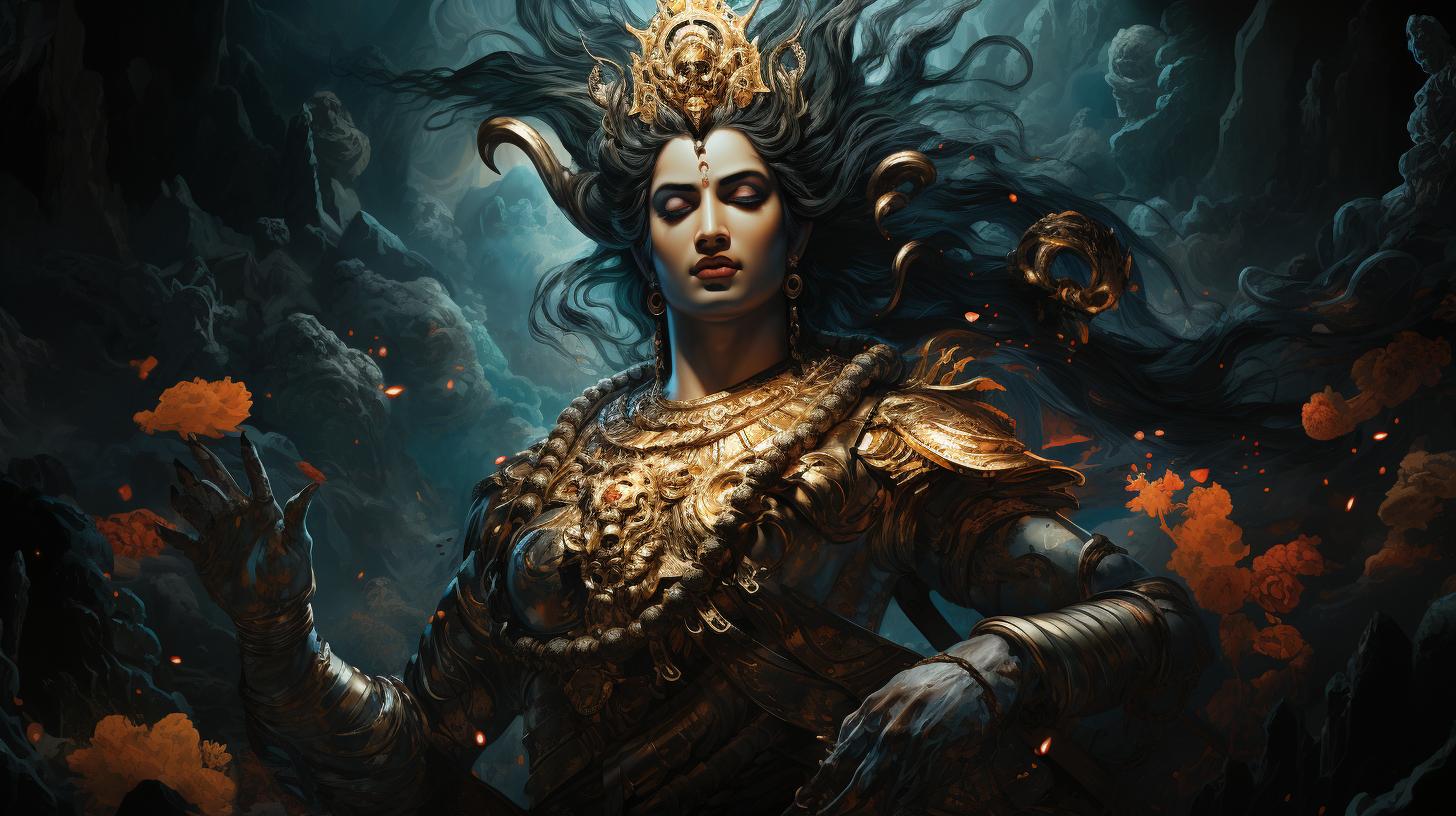‘Hindu God Agni: The Fiery Deity of India’
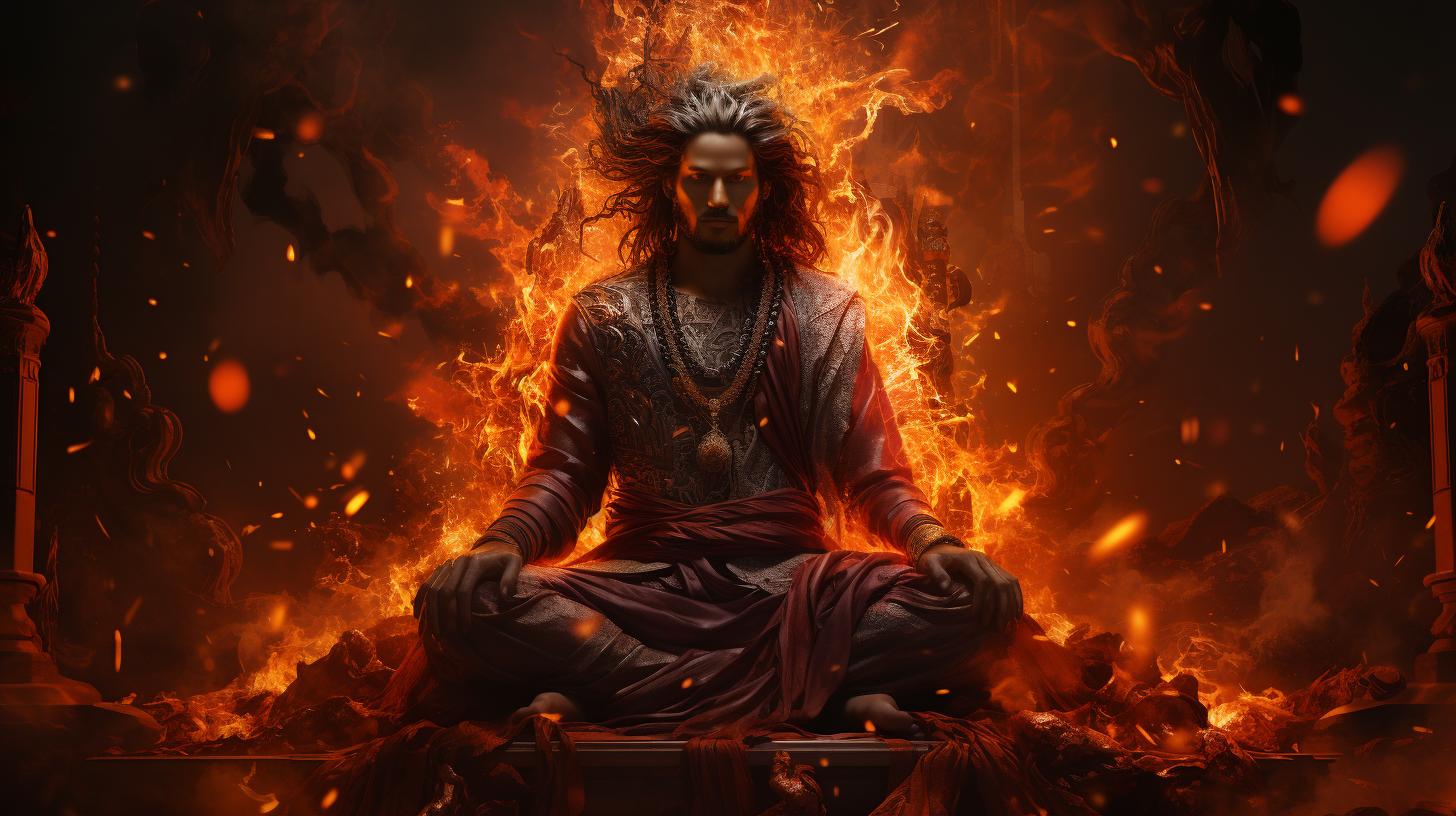
Agni, the Hindu god of fire, holds significant importance in Vedic mythology. Known for his distinctive physical attributes such as fiery hair and multiple faces, he is considered the second most important deity after Indra. Agni serves as a guardian deity, invoked during ceremonies and acting as a communication link between humans and gods.
Associated with various forms of fire, including the sun and domestic hearths, Agni plays a crucial role in rituals and sacrifices. In Hindu art, he is often depicted with flaming hair, riding a ram.
Agni’s connection to transformation extends to the practice of yoga, where he represents vitality and spiritual growth. Worship of Agni involves the preparation and lighting of a sacred fire, with offerings and mantras seeking blessings of protection, purification, and transformation.
Agni in Vedic Mythology
Agni, the god of fire in Hinduism, holds a significant place in Vedic mythology. Regarded as one of the most important deities, Agni is highly revered and plays various roles in ancient Indian beliefs and traditions.
Known for his fiery nature, Agni symbolizes the transformative power of fire and its vital role in rituals and ceremonies. He is considered the mouth of the gods and goddesses, serving as a messenger between the human and divine realms.
Revered for his association with fire in its numerous forms, such as the sun, lightning, household fires, and sacrificial fires, Agni is invoked and worshipped by Brahmins and devotees.
Agni is often depicted with distinct physical attributes.
His reddish tone and hair that emanates flames are striking features. He is said to have multiple faces, tongues, three legs, and seven arms, each representing his divine power and cosmic significance.
In the Vedic pantheon, Agni holds the responsibility of delivering human offerings to the gods during ritual sacrifices. With his connection to fire and transformation, Agni facilitates spiritual growth and is regarded as a conduit for purification and protection.
Throughout Hindu art, Agni is portrayed with his flaming hair, representing his association with fire and its intense energy. Additionally, Agni is often depicted riding a ram, signifying his power and authority.
Exploring Agni’s role in ancient Vedic mythology provides insights into the rich symbolism and spiritual significance attributed to the god of fire.
Physical Attributes of Agni
Agni, the Hindu god of fire, possesses unique physical attributes that set him apart from other deities. These distinctive features emphasize his fiery nature and symbolize his importance within Hindu mythology.
Reddish Tone and Flaming Hair
Agni is often depicted with a reddish tone, symbolizing the intense heat of fire. His complexion radiates a vibrant hue, reflecting the fiery essence he embodies. In artistic representations, Agni’s hair stands erect like flames, representing his connection to the transformative and purifying powers of fire.
Multiple Faces and Tongues
Another striking attribute of Agni is his ability to manifest multiple faces and tongues. This symbolic portrayal signifies his vast presence and his capacity to be the mouthpiece of gods and goddesses.
Agni acts as a mediator between the divine and human realms, conveying messages and bridging the gap between the two.
Three Legs and Seven Arms
Agni is often depicted with three legs and seven arms, showcasing his exalted position and power. The three legs symbolize his presence in the three worlds of heaven, earth, and the atmosphere.
His seven arms exemplify his ability to carry out multiple functions and responsibilities. Each arm represents a specific role and serves as a conduit for the offerings and sacrifices made by humans.
Agni as a Guardian Deity
Agni’s role as a guardian deity is of great importance in Hindu mythology. He is invoked and revered in various ceremonies and rituals for his divine presence and protection. Let’s explore the different aspects of Agni’s role as a guardian deity:
Invocation and Importance in Ceremonies
Agni is specifically invoked in ceremonies, particularly by the Brahman priests known as Agnihotri.
His presence is believed to purify and bless the surroundings, ensuring the success and auspiciousness of the ritual. As the mouthpiece of the gods and goddesses, Agni holds a significant position in the ceremonial practices.
Messenger Between Human and Divine
Agni acts as a messenger, bridging the gap between the human and divine realms. It is through Agni that the prayers and offerings of humans reach the gods, establishing direct communication with the divine.
In this role, Agni represents the link between the mortal and immortal, facilitating the exchange of desires, blessings, and divine guidance.
Associations with the Sun, Lightning, and Domestic Fires
Agni is not just limited to traditional sacred fire. He is also associated with the sun, which represents vital energy and illuminates the world. Additionally, Agni is linked to lightning, which symbolizes his fiery essence and power.
Furthermore, Agni is closely connected to domestic fires, representing the sacred hearth of homes where he resides, providing warmth, light, and protection to households.
From his role in ceremonies to his function as a messenger and his associations with the sun, lightning, and domestic fires, Agni’s presence as a guardian deity is highly revered and sought after.
Embodying the transformative and purifying aspects of fire, Agni serves as a spiritual guide, offering protection, blessings, and a vital connection between the human and divine realms.
Agni’s Family and Responsibilities
Agni, the god of fire in Hinduism, not only holds immense importance in rituals and ceremonies but also has a family and specific responsibilities associated with his divine role.
Let’s explore Agni’s familial connections and his duties in more detail.
Marriage and Descendants
Agni is married to the daughter of King Nila, and their union has resulted in the birth of a son named Karttikeya. This familial bond highlights Agni’s role as a father and husband within the pantheon of Hindu gods.
Karttikeya, known as the god of war, symbolizes valor and is revered as a powerful deity in his own right.
Role in Ritual Sacrifices and Offerings
As the god of fire, Agni plays a pivotal role in ritual sacrifices and offerings. He is responsible for receiving and carrying the offerings made by humans to the gods during these sacred ceremonies.
Through this responsibility, Agni acts as a mediator, conveying the prayers and desires of devotees to the divine realm.
Carrying Human Offerings to the Gods
Agni’s duty to carry human offerings extends beyond ritual sacrifices. He ensures that the prayers, praises, and gifts presented by individuals reach the gods. This divine responsibility signifies Agni’s pivotal role as the intermediary between the mortal realm and the realm of gods.
By facilitating this connection, Agni plays a crucial part in the communication and fulfillment of the wishes and needs of devotees.
In conclusion, Agni’s family and responsibilities form an integral part of his identity as the god of fire.
Through his marriage and descendants, Agni showcases the importance of family within the divine pantheon. His crucial role in ritual sacrifices and offerings, as well as his responsibility to convey human offerings to the gods, emphasize his role as a messenger and mediator between the mortal world and the divine realm.
Acknowledging Agni’s familial connections and duties deepens our understanding of his significance in Hindu mythology.
Agni in Hindu Art and Symbolism
Agni, the revered Hindu god of fire, is commonly depicted in Hindu art with distinct symbolism. These artistic representations capture Agni’s significance and emphasize his fiery nature.
Depictions with Flaming Hair and Riding a Ram
In artistic portrayals, Agni is often depicted with hair that appears like flickering flames, symbolizing his association with fire.
This representation showcases Agni’s fiery essence and his connection to the elemental power of flames. Furthermore, Agni is sometimes shown riding a ram, symbolizing his role as a force of transformation and a guide between the earthly and divine realms.
The flaming hair and ram-mounted depiction of Agni highlight his dynamic and powerful nature. These artistic representations serve as a visual reminder of Agni’s vital role in facilitating transformation, connecting humans with the divine, and bridging the gap between the physical and spiritual worlds.
Artworks featuring Agni with flaming hair and riding a ram are a testament to the artistic imagination and creativity within Hindu culture. They carry deep symbolism and provide a visual representation of Agni’s fiery attributes and his overarching significance in Hindu mythology and religious practices.
Agni’s Significance in Yoga Practice
The Hindu god Agni holds great significance in the practice of yoga, representing essential elements that contribute to transformation and spiritual growth.
Vital Element and Representation of Transformation
Agni is revered as a vital element in yoga, symbolizing the transformative power within. Just as fire has the ability to change substances, Agni represents the inner fire that fuels personal growth and evolution.
By harnessing this transformative energy, practitioners can cultivate positive change, letting go of what no longer serves them and embracing new possibilities.
Cultivating Connection for Spiritual Growth
Connecting with Agni is an integral aspect of spiritual growth in yoga. Through a dedicated yoga practice, individuals strive to establish a deeper connection with themselves, others, and the divine. Agni acts as a guiding force, aiding in the cultivation of this connection.
By invoking Agni’s presence and embracing the fire within, practitioners can tap into their inner strength, authenticity, and spirituality.
As yoga enthusiasts embark on their journey, Agni’s significance serves as a reminder of the inherent potential for transformation and the importance of nurturing connection for spiritual growth.
Worship and Rituals Dedicated to Agni
Worship and rituals dedicated to Agni hold a significant place in Hindu religious practices. It involves the veneration of Agni as the sacred fire and the messenger between the human and divine realms.
The rituals associated with Agni are performed with great reverence and devotion, offering mantras, prayers, and various offerings.
Preparation and Lighting of Sacred Fire
The worship of Agni commences with the preparation and lighting of a sacred fire, which serves as a focal point for the rituals. Brahman priests meticulously arrange the fire, following specific rituals and traditions.
The fire, often ignited using a flint or magnifying glass, represents Agni’s divine presence and is considered a gateway to the gods.
Offerings and Mantras in Worship
During the worship and rituals dedicated to Agni, various offerings are made to the sacred fire. These offerings include ghee (clarified butter), grains, fruits, and aromatic substances. The offerings are carefully placed into the fire while chanting mantras and invoking the divine presence of Agni.
The mantras, specific to each ritual, hold deep spiritual significance and emphasize the devotee’s connection with Agni and the divine forces.
Blessings of Protection, Purification, and Transformation
Through the worship of Agni, believers seek blessings of protection, purification, and transformation. Agni is believed to have the power to purify and cleanse individuals, removing impurities and negativity. Devotees also seek Agni’s assistance in transformation, both at a personal and social level.
The fire serves as a symbol of change, driving individuals towards spiritual growth and enlightenment.
By actively engaging in the worship and rituals dedicated to Agni, devotees strive to establish a deeper connection with the divine, seeking blessings for their well-being, spiritual progress, and harmony in their lives.
.

